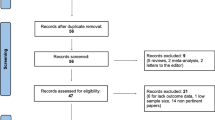Abstract
Retro-palatal obstruction is often involved in the pathogenesis of obstructive sleep apnea syndrome (OSAS), which is currently treated by means of various surgical procedures. The aim of this paper is to describe our preliminary results using a new, minimally invasive and non-resective procedure called the “barbed Roman blinds technique” (BRBT), which was used to treat severe OSAS due to retro-palatal obstruction. The apnea–hypopnea index (AHI), time with <90 % O2 saturation, and Epworth Sleepiness Scale (ESS) of 32 consecutive adult outpatients (mean age 47.3 ± 8.6 years) were compared before and after surgery. The tolerability of the procedure was assessed using a 0–10 visual analog scale (VAS). All of the treated patients experienced a clinical and subjective improvement as documented by the significant differences (P < 0.001) in their pre- and post-BRBT AHI, time with <90 % O2 saturation, and ESS scores. There were no minor or major adverse events, and the good tolerability of the procedure was documented by the short mean hospital stay (1.2 ± 0.5 days) and the mean VAS value of 4.3 ± 0.7. The mean follow-up period was 12.2 ± 2.0 months. The preliminary results indicate that the BRBT is safe and effective, but long-term follow-up and comparative studies of larger case series are needed to confirm these encouraging findings.







Similar content being viewed by others
References
Vicini C, De Vito A, Benazzo M, Frassineti S, Campanini A, Frasconi P, Mira E (2012) The nose oropharynx hypopharynx and larynx (NOHL) classification: a new system of diagnostic standardized examination for OSAHS patients. Eur Arch Otorhinolaryngol 269:1297–1300
Kezirian EJ, Hohenhorst W, de Vries N (2011) Drug-induced sleep endoscopy: the VOTE classification. Eur Arch Otorhinolaryngol 268:1233–1236
Walker-Engström ML, Tegelberg A, Wilhelmsson B, Ringqvist I (2002) 4-year follow-up of treatment with dental appliance or uvulopalatopharyngoplasty in patients with obstructive sleep apnea: a randomized study. Chest 121:739–746
Won CH, Li KK, Guilleminault C (2008) Surgical treatment of obstructive sleep apnea: upper airway and maxillomandibular surgery. Proc Am Thorac Soc 5:193–199
Franklin KA, Anttila H, Axelsson S, Gislason T, Maasilta P, Myhre KI, Rehnqvist N (2009) Effects and side-effects of surgery for snoring and obstructive sleep apnea—a systematic review. Sleep 32:27–36
Aurora RN, Casey KR, Kristo D, Auerbach S, Bista SR, Chowdhuri S, Karippot A, Lamm C, Ramar K, Zak R, Morgenthaler TI (2010) Practice parameters for the surgical modifications of the upper airway for obstructive sleep apnea in adults. Sleep 33:1408–1413
Värendh M, Berg S, Andersson M (2012) Long-term follow-up of patients operated with uvulopalatopharyngoplasty from 1985 to 1991. Respir Med 106:1788–1793
Schwartz AR, Gold AR, Schubert N et al (1991) Effect of weight loss on upper airway collapsibility in obstructive sleep apnea. Am Rev Respir Dis 144:454–459
Schellemberg JB, Maislin G, Schwab RJ (2000) Physical findings and the risk for obstructive sleep apnea: the importance of oropharyngeal structures. Am J Respir Crit Care Med 162:740–748
Schwab RJ, Pack AI, Gupta KB, Metzger LJ, Oh E, Getsy JE, Hoffman EA, Gefter WB (1996) Upper airway and soft tissue structural changes induced by CPAP in normal subjects. Am J Respir Crit Care Med 154:1106–1116
Schwab RJ (2003) Pro: sleep apnea is an anatomic disorder. Am J Respir Crit Care Med 168:270–271
Strohl KP (2003) Con. Sleep apnea is not an anatomic disorder. Am J Respir Crit Care Med 168:271–272
Cahali MB (2003) Lateral pharyngoplasty: a new treatment for obstructive sleep apnea hypopnea syndrome. Laryngoscope 113:1961–1968
Pang KP, Woodson BT (2007) Expansion sphincter pharyngoplasty: a new technique for the treatment of obstructive sleep apnea. Otolaryngol Head Neck Surg 137:110–114
Mantovani M, Minetti A, Torretta S, Pincherle A, Tassone G, Pignataro L (2012) The velo-uvulo-pharyngeal lift or “roman blinds” technique for treatment of snoring: a preliminary report. Acta Otorhinolaryngol Ital 32:48–53
Tonnard P, Verpaele A (2007) Short-Scar Face Lift: operative Strategies and Techniques. St. Louis. Quality Medical Publishing
Mantovani M, Minetti A, Torretta S, Pincherle A, Tassone G, Pignataro L (2013) The “Barbed Roman Blinds” technique: a step forward. Acta Otorhinolaryngol Ital 33:128
Belgü AU, Erdoğan B, San T, Gürkan E (2014) The relationship between AHI, Epworth scores and sleep endoscopy in patients with OSAS. Eur Arch Otorhinolaryngol 5 (epub ahead of print)
Johns MW (1991) A new method for measuring daytime sleepiness: the Epworth sleepiness scale. Sleep 14:540–545
Janson C, Noges E, Svedberg-Randt S et al (2000) What characterizes patients who are unable to tolerate continuous positive airway pressure (CPAP) treatment? Respir Med 94:145–149
Sorrenti G, Piccin O (2013) Functional expansion pharyngoplasty in the treatment of obstructive sleep apnea. Laryngoscope 123:2905–2908
Woodson BT, Sitton M, Jacobowitz O (2012) Expansion sphincter pharyngoplasty and palatal advancement pharyngoplasty: airway evaluation and surgical techniques. Operative Tech Otolaryngol Head Neck Surg 23:3–10
Sumida K, Yamashita K, Kitamura S (2012) Gross anatomical study of the human palatopharyngeus muscle throughout its entire course from origin to insertion. Clin Anat 25:314–323
Tsai YJ, Ramar K, Liang YJ, Chiu PH, Powell N, Chi CY, Lung TC, Wen-Yang Lin W, Tseng PJ, Wu MY, Chien KC, Weaver EM, Lee FP, Lin CM, Chen KC, Chiang RP (2013) Peripheral neuropathology of the upper airway in obstructive sleep apnea syndrome. Sleep Med Rev 17:161–168
Strollo PJ Jr, Soose RJ, Maurer JT, de Vries N, Cornelius J, Froymovich O, Hanson RD, Padhya TA, Steward DL, Gillespie MB, Woodson BT, Van de Heyning PH, Goetting MG, Vanderveken OM, Feldman N, Knaack L, Strohl KP; STAR Trial Group (2014) Upper-airway stimulation for obstructive sleep apnea. N Engl J Med 370:139–149
Acknowlegdments
Thanks to Patrizia Viola for illustrations.
Author information
Authors and Affiliations
Corresponding author
Ethics declarations
Financial disclosure
No financial support was received for this study
Rights and permissions
About this article
Cite this article
Mantovani, M., Rinaldi, V., Torretta, S. et al. Barbed Roman blinds technique for the treatment of obstructive sleep apnea: how we do it?. Eur Arch Otorhinolaryngol 273, 517–523 (2016). https://doi.org/10.1007/s00405-015-3726-2
Received:
Accepted:
Published:
Issue Date:
DOI: https://doi.org/10.1007/s00405-015-3726-2




